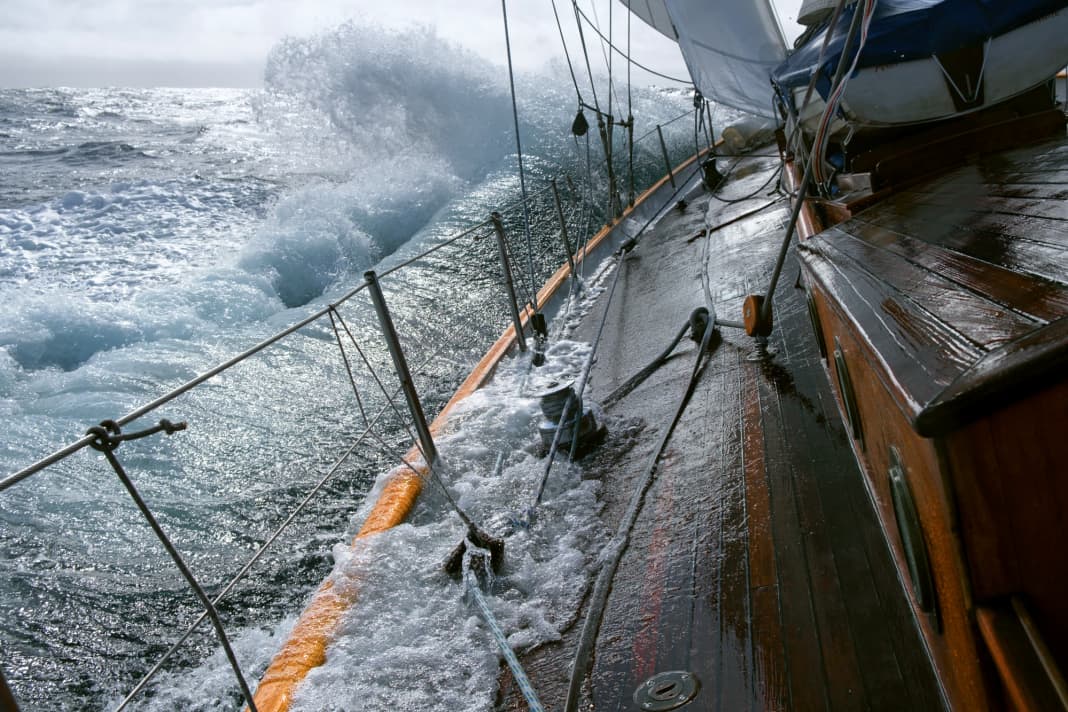





The waiter is beaming all over his face. "Voici vos entrées!" In a great mood, Jérôme serves us fresh seafood as a starter. We have arrived: after six days, our first shore leave in Roscoff in the north of Brittany. Chablis by the glass and fantastically prepared fish on the plate lift our spirits at "Les Arcades". Even skipper Christoph is happy. He had actually wanted to eat on board. The sea and his boat are enough to make him happy. But now he savours the sea bass with lemon butter. By the time the tarte tatin is served for dessert, we are already in "Do you remember?" mode.
Time for memories. Of the North Sea, of storms, rain and cold. Of situations we experienced together, tasks we mastered together, things we overcame together. Of moments full of tension, effort and excitement.
Bad weather is forecast for the start of the trip in the small marina of Seestermühe at the mouth of the Krückaum north of Hamburg. In order to be able to leave early the next day, regardless of the tide, we quickly move the ship to the nearby harbour of Glückstadt. Heinz meets the crew later in the "Logger galley" over matjes and beer. The ship's doctor had the longest journey from Lake Constance.
Sailing with a colourful crew
A colourful bunch came together for the ferry trip to Lisbon. Paul, the IT specialist from Hamburg, has handed over the management to a colleague for three months. He is sailing to the Caribbean on the "Peter von Seestermühe". Philip from Oslo has signed on as a bosun on the two-master built in Gdansk in 1936. At least as far as the Canary Islands. Jochen is taking six weeks off from his law firm in Frankfurt. In just 14 days, Henning will be back at his desk at a bank. He takes up residence in Baiona. Frieder from Wuppertal can no longer leave his carpentry workshop alone either. Retiree Maarten, on the other hand, has time on his hands. The man from Amsterdam is looking forward to a three-week sea voyage to Portugal.
As we cast off, Christoph urges us to hurry. He wants to leave the Elbe estuary before the bad weather sets in and get out of the German Bight as soon as possible. "We don't have a coffee trip ahead of us!" he says.
Repeaters find it easier to work on deck. Jochen was already on board in the summer as a bunk charterer on a trip to Bergen. Frieder has been sailing regularly for 20 years on the steel ship that everyone affectionately calls "Peter". He leads watch 1. It's all about getting stuck in. Because: "We're not on a coffee cruise!" Everyone has to get involved, not only on deck, but also in the bakehouse. Two men are always responsible for keeping things running below deck. "Good catering and fresh food are a valuable asset," is the boss's credo.
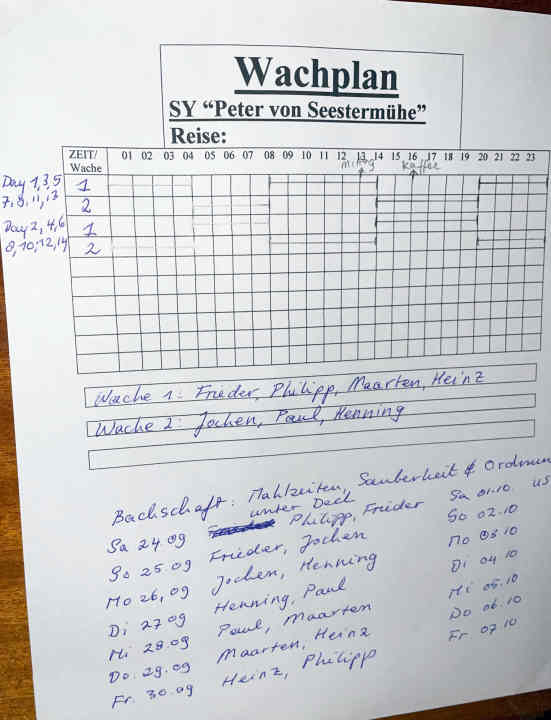
As it gets lighter, we pass the nuclear power plants in Brokdorf and Brunsbüttel. Not an idyll, but reality. The reality on board soon becomes clear. "Where's that ferry coming from over there?" - "From the other bank!" North German pun. On-board language: straightforward. The skipper shows the way. His announcements are clear, authoritative and decisive.
The wind is favourable. Time to set sail. The novices on board hesitate. Everything works perfectly. But how? The mainsheet, which has been deflected eight times, is taken out of the hand and laid on deck in front of the chart house. The jib is attached to the forestay with stays. The top and bottom stays need to be operated. And quickly. The command "Jib up!" has not yet died away when the call comes from the helm: "Today!" Motto of the day: "We're going to sea here!"
Further team building includes instruction in rescue equipment, navigation and communication as well as behaviour in an emergency. Important and patiently explained by the skipper. This provides security - a good feeling. It needs that too. It freshens up towards evening. We are running high into the wind off Langeoog when preparations for a stormy night begin. The trysail is prepared, the dinghy firmly lashed down and the smaller headsail hoisted.
Gathering strength for the first night on board
Meanwhile, Frieder and Jochen serve dinner in the cosy lounge. Freshly prepared, of course. It's time to gather strength for the first night at sea. It turns out to be cold and wet. We sail on the edge of the wind. Constant rain and waves repeatedly coming over the flat bow make the first watch a real test. After tacking, Frieder pulls the jib sheet tight while standing up to his knees in water. Hard labour. Longing for the change of watch at midnight. Exhausted, watch 1 retires to the cramped bunks. There are not even four hours to recover. The short, unpredictable waves of the shallow North Sea give the crew a good shake. A number of falls delay the dressing and undressing for the watch change at four o'clock in the morning. It becomes tedious.
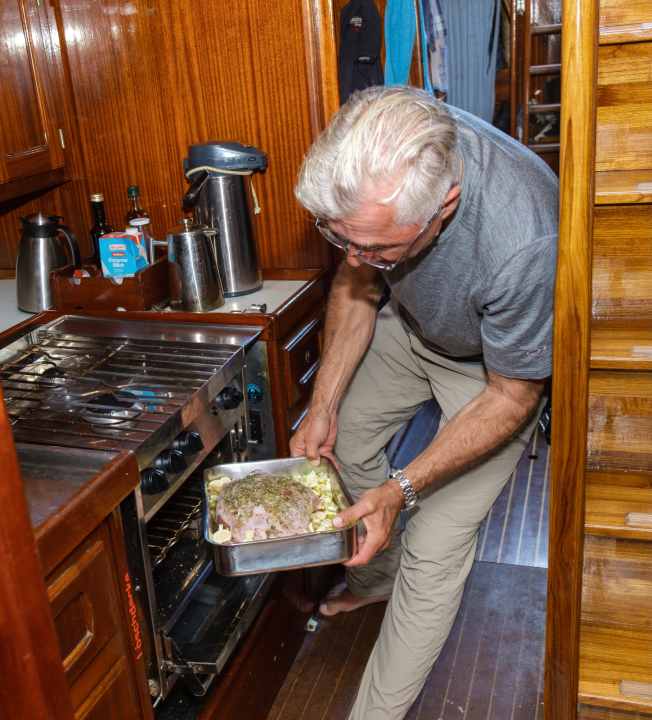
Frieder keeps his watch together. He talks about his experiences on the "Peter". He has already experienced 12 Beaufort in the Bay of Biscay with Christoph. That connects us. And gives us newcomers courage. Ginger tea and a bar of chocolate help us through the dark night. No time for photos of seething seas, pitching boats and suffering mates. Now it's time to sail. Sailing at the limit.
"I can't imagine anything better. I can clear my head here. Even as a boy, I dreamed of it." As the boat pounds through the rough seas, Frieder explains how he "honed his skills" as a teenager on traditional English sailing ships. The ability to survive at sea, even in the most adverse conditions. Just like now. At eight o'clock, Henning takes over watch 2 and the North Sea rages on.
Watchful eye while sailing
When Christoph von Reibnitz took over the "Peter" from the Akademischer Seglerverein Kiel in 1991, the ship had already travelled around the world several times, but was in a miserable condition. The then 25-year-old new owner transformed the yawl back into a reliable boat with traditional style and modest comfort. When sailing, he is ready when needed. He supports difficult manoeuvres when necessary. He keeps an eye on the weather and always keeps an eye on his crew. When the doctor is off due to seasickness, he lets him rest.
"It was as if the plug had been pulled on me. No more strength. Tiredness instead. Not even so much nausea," reports Heinz when reporting for duty after missing two watches. Henning brings him salt sticks. That helps. With his eyes fixed on the horizon, Heinz listens to his benefactor talk about his own experiences with seasickness. "It's probably part of it somehow," says Frieder. The old sailor has only been struck by misery for a few years, usually at the beginning of his trips. "I also had a hard time at the beginning. It gets better after a few days. Then it's over for the rest of the trip," he says, offering comfort. "Take the helm after the change of watch," is his advice. A good tip.
Obstacles on the high seas
Concentration is required as the "Peter" approaches the first wind turbines of East Anglia One off the south-east coast of England. We cruise alongside them in choppy seas. There is no doubt that such wind farms are important for the energy supply. However, they make navigation even more difficult. As if the numerous oil rigs weren't enough of an obstacle.
Our two-master approaches the Strait of Dover or Pas de Calais. Regardless of the language, the name of the strait inspires awe in sailors. At its narrowest point between Cap Gris-Nez in Gaul and Folkestone in Britain, it measures just 19.1 nautical miles. At low tide, it is only 17 nautical miles from the breakwaters off Dover to the Cape. 400 ships pass through this bottleneck every day.
In the chart house, Christoph and the watch leaders plan the course through the approaching shallows. They need to keep clear of the traffic separation scheme on the port side. The Goodwin Sands, a chain of sandbanks off the coast, lurk to starboard. White flashes ahead every 15 seconds. The course is set. In a stiff breeze and half wind, Heinz enjoys the approach to the lightship "East Goodwin". As Philip takes over, the lantern buoys of SE Goodwin and S Goodwin show the way with red flashing lights. The lights of the ocean liners in the Dover Strait Traffic Separation Scheme pass by on the port side. What a backdrop! Still, no time for sailing romance. Heinz and Maarten are assigned to the bakehouse. A short nap will have to suffice. Only the boys on watch 2 will see the chalk cliffs of Dover. We're not on a coffee cruise!
Where do I start?" Maarten asks himself when he starts work at seven in the morning. As far removed from household skills as Donald Trump is from good behaviour, he is fortunately relieved of duty due to a fall injury to his arm. So Doc is left alone as a baker. "How to find everything?" There are weeks' worth of supplies stowed in the belly of the ship.
No compromises during the cruise
"At sea, we cook fresh and eat properly!" The skipper does not tolerate compromises. The boss's personal familiarisation is based on the motto "Explaining twice is too much once." Christoph is tolerant. It doesn't matter who prepares breakfast, the main thing is that the egg from his own chickens is hard-boiled. Very hard. Brewing coffee, slicing sausage and cheese, making tea, cutting the wholemeal bread into eight-millimetre-thin slices, presenting Frieder's muesli, Jochen's Nutella, Heinz's orange juice, Paul's soft-boiled egg, Philip's jam and Maarten's old Gouda on the large wooden table in the lounge becomes an art in what feels like 35-degree winds in the English Channel. The good atmosphere at breakfast makes up for the effort.
It went well. The boiling water on the gimballed cooker stayed in the pot. Sponge over it. On to the washing up. The next challenge. Fresh water is limited. So cleaning the crockery becomes a balancing act between hygiene and the need to save money. That also needs to be learnt. Finally everything is put away. Time to take a breath on deck. To starboard, the Seven Sisters, the chalk cliffs between Eastbourne and Seaford on the south coast of England, form the backdrop for photos of a happy crew. Jochen and Henning enjoy the journey under full sail in the cockpit. Relaxation is the order of the day. We are sailing.
Consultation between doctor and skipper while sailing
But relaxation makes you careless. "Doctor, quick, Paul has bruised his thumb!" Treatment with on-board aids, cooling, bandage. Paul will be able to continue his journey. It's a different story for Maarten. The elbow he injured in the fall has become inflamed. It is swelling up. The doctor and skipper need to talk. Taking Maarten across the Bay of Biscay seems risky. Heinz advises, the skipper decides. Tomorrow we dock in Roscoff. Maarten needs intensive treatment and will disembark.
Jochen steps in as a baker. As the sea becomes calmer, he will serve leg of lamb for dinner. Restriction from the skipper: "Only serve food to showered people!" There has been no opportunity for extensive personal hygiene since the mouth of the Elbe. Over time, this becomes noticeable and odourless. Henning makes the start. Salty water pours over his head on the aft deck. Pütz for Pütz. A role model for the rest of the crew.
A look at the plotter later shows us the special features of the English Channel. Travelling at five knots through the water, our speed over ground is zero - local tidal currents. The Channel Islands of Alderney, Guernsey and Jersey remain nailed to our port side. We are making no progress. Only when the tide turns does our position change permanently. Then the wind falls asleep. We motor through a starry night.
Stop in Roscoff
Roscoff welcomes us to the Bloscon Marina with its marvellous showers. While our clothes are washed in large washing machines to remove the sweat from our journey, we savour the aroma of fresh croissants and café au lait. Warm rays of sunshine invite us to explore the botanical garden on the cliff high above the marina. From up there, the view stretches far across the bay of Morlaix with its oyster beds. As you stroll through the old town, the fishing boats in the harbour have fallen dry. Pétanque players lend the village a Breton flair.
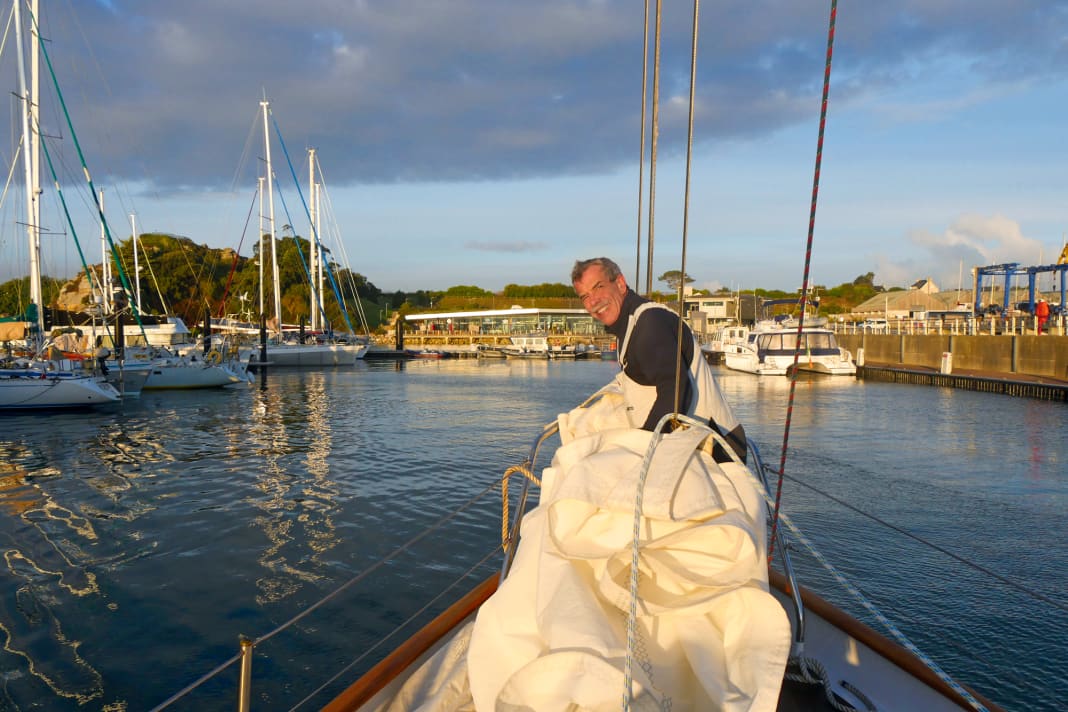


A good weather window calls for departure. As the wind and waves collide while we're crossing against a strong westerly wind, spray splashes into the cockpit. Still in daylight, we recognise the granite island of Ouessant in the distance. Only around 800 inhabitants brave the stormy weather on France's westernmost outpost. The Phare du Créac'h, with its enormous range of 32 nautical miles, guides us safely around the western tip of the island. As Watch 1 makes the last of countless tacks to the north-west of the island at night, 340 nautical miles of the Bay of Biscay lie ahead of us on the way to Galicia. It lives up to its reputation: 7 Beaufort from the southwest pushes the 30-tonne yacht onto its side. The mainsail is recovered. Under jib, foresail and mizzen, the "Peter" is now pounding through heavy seas at a speed of seven and a half knots.
Showtime in the forecastle while sailing in stormy seas
It's showtime in the forecastle. It's not easy to climb into the upper berth. Even lying down becomes a sport. The ship's movements need to be constantly balanced.
The wind shifts towards evening. We set a course of 215 degrees with the jib unfurled and the bullstander on the main. The next morning, Christoph, who always carries enough nationals as a spare, has decorated the saloon with three flags. It is the 3rd of October. Half wind and calm seas create a holiday atmosphere. All the more so when the spinnaker is set in glorious sunshine.
"The Bay of Biscay as a recreational area," runs through Heinz's mind as he spends a long time at the helm keeping the luff of the mighty canvas from collapsing. The skipper enhances the festive day with 0.1 litres of red wine per head to accompany the roast lamb. During the evening skat, the words escape him: "You've steered better today than you've dealt now." The accolade?
Stop in Cedeira
We drop anchor in the bay of Cedeira. It protects us from the strong wind from the south-west at Cape Finisterre on the north-western tip of Spain. It's still summer on Galicia's coast. A morning swim in the sea is followed by a walk ashore. Street cafés and small bars invite you to linger. In the tranquil town, baker Paul finds everything he needs to replenish his supplies.
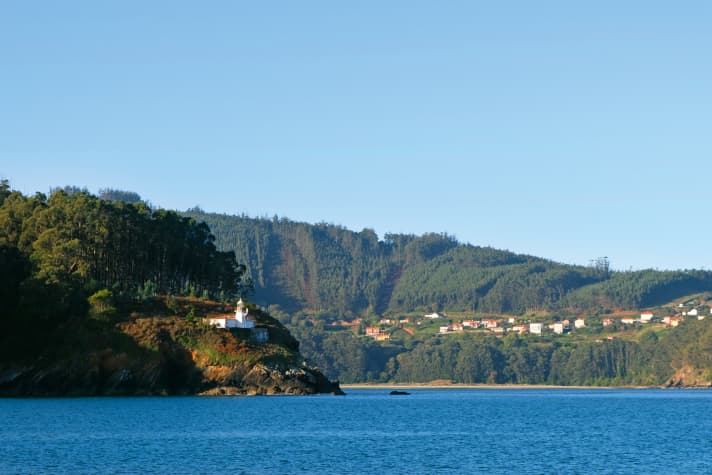
The next afternoon, it's "anchor up" under sail. We cross out of the narrow bay in a light, shifting wind. Not an easy endeavour. It takes patience - but no engine. Trusting in the ship and crew, the skipper takes command just before the rocks to leeward: "Rudder hard to starboard", "Jib ready to drop", "Pick up speed", "Jib drops", "Rudder hard to port", "Hot on the jib", "Drop ten degrees". One tack later, we are on course for the open sea. "What's this awesome boat?" mumbles Christoph on the way into the chart house. He's right.
The medieval fortress of Baiona towers above the entrance to the Monte Real Yacht Club de Yates. On the approach after a marvellous night sail on the Atlantic, the beautiful sandy beaches at the foot of the castle hill soon come into view. Extensive jetties divide the bay below Monte Real. Antonio catches our lines and ties up. The harbour master has reserved a quiet spot for us outside.
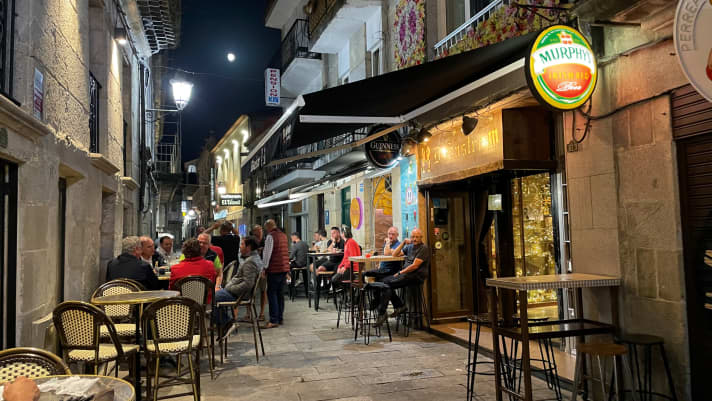
As soon as we have finished mooring, the bakers Paul and Jochen are drawn to the old town for provisions. Life pulsates in the narrow alleyways. Tiled façades lend the town centre a special charm. The displays of the patisseries, butchers and bakeries invite you to feast. Cheerful guests fill the terraces of the bars and cafés. Baiona is also popular in the off-season. Our crew celebrates their arrival with a feast in "El Patio". Afterwards, the evening ends in the venerable clubhouse with a glass of Alvarinho, the fruity white wine typical of the region. "Clear ship" and crew change are behind us as we head south.
View over Viana do Castelo
A fine drizzle accompanies the entry into the harbour of Viana do Castelo on the other side of the border. A visit to the pretty pedestrianised area with its bars, kiosks and shops shows the harbour town at its best. The shrine of Santa Luzia is well worth a visit. The funicular railway to the church on the hill high above the old town, inaugurated in 1959, is out of service. The strenuous climb up the never-ending staircase is rewarded with a breathtaking view of the city and the Atlantic Ocean.
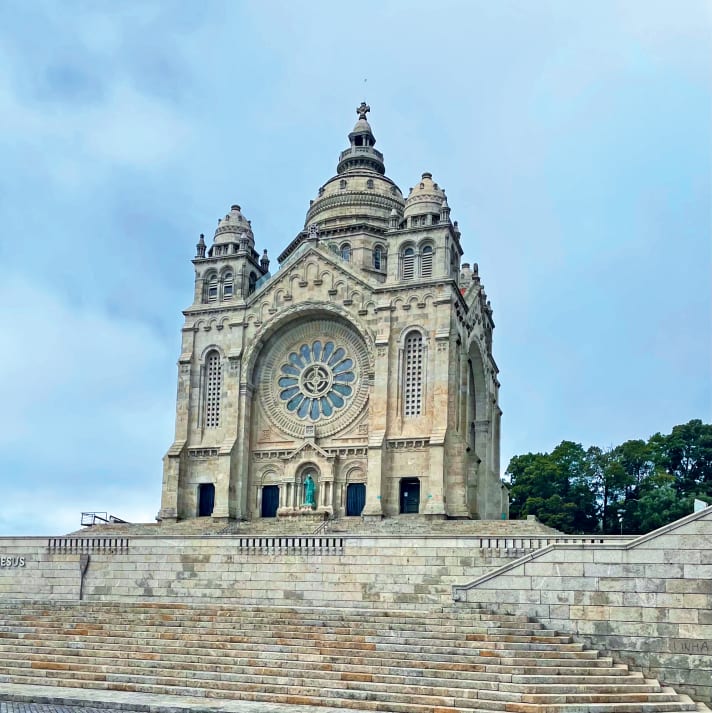
We still have two days of travelling ahead of us. Time for minor repairs on deck. Philip carries out maintenance work. A real boatman. From now on, the long Atlantic swell is part of the scenery. "What a landscape!" enthuses Alex, the new man on board, as the "Peter" heads towards its destination on a clear full moon night. The ship rolls, the lonely expanse of the ocean at night is captivating.
It could go on like this. But all too soon we reach the mouth of the Rio Tejo and dock in Cascais. Here, on the outskirts of Lisbon, the charm of old manor houses mingles with modern tourist facilities. Even in October, the marvellous beaches are still extremely busy.
Heinz and Jochen disembark here after three weeks of sailing, experiencing and enjoying life together. The constantly changing conditions of weather, sea and landscape have exerted them, sometimes made them suffer, but above all: fascinated them. Over tapas and chilled Vinho Verde, they agree as they say goodbye: "It really wasn't a coffee trip!"
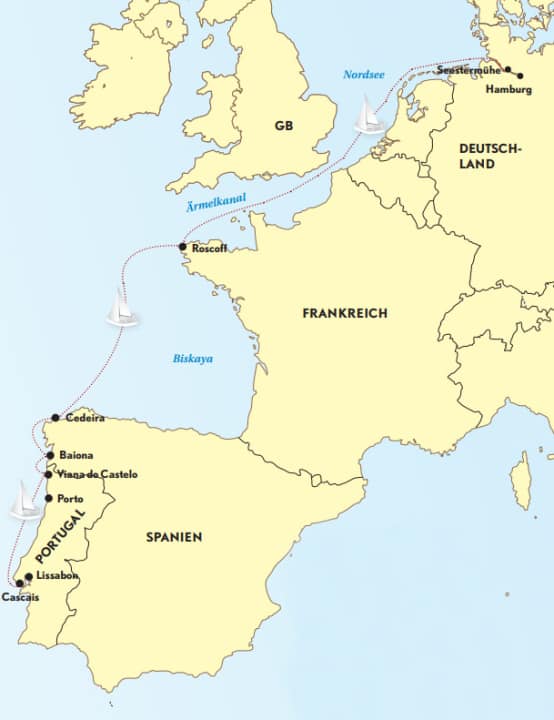
The stage stops on the way south while sailing
Roscoff
The town was already a centre for thalassotherapy in the 19th century due to its mild sea climate. Worth seeing are the botanical gardens on a cliff, the Maria Stuart House, where the Scottish queen is said to have lived for five years, as well as the marine institute and research aquarium. Mudflat walks in the Baie de Morlaix and in the direction of Île de Batz are also very attractive.
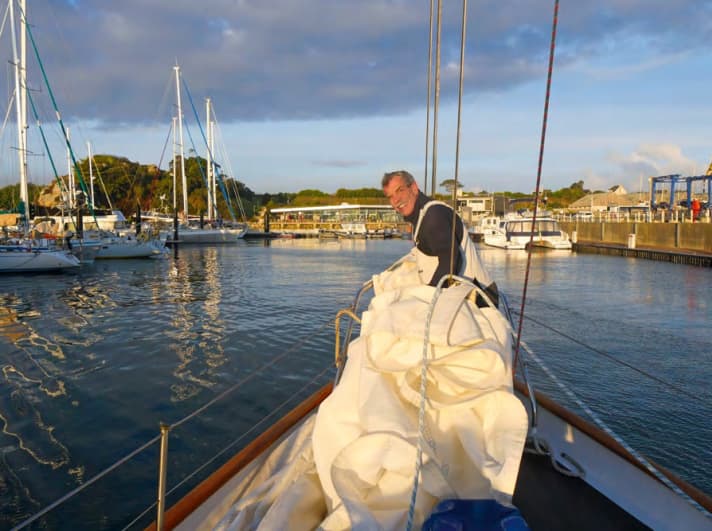
Cascais
Magnificent old manor houses characterise the townscape, as does the fortress overlooking the harbour. However, holidaymakers come to Cascais mainly because of the beautiful sandy beaches, which last until autumn. The Parque Marechal Carmona with its old trees, many fountains and unconventional sculptures is well worth a visit. The natural spectacle of the Boca do Inferno on the outskirts of the town is impressive: at high tide, the waves of the Atlantic crash against the cliffs. The spray is hurled high up through vertical rock chimneys. The Cascais marina is large, with 650 berths. A train journey along the coast and the banks of the Rio Tejo is a highlight when visiting Lisbon.
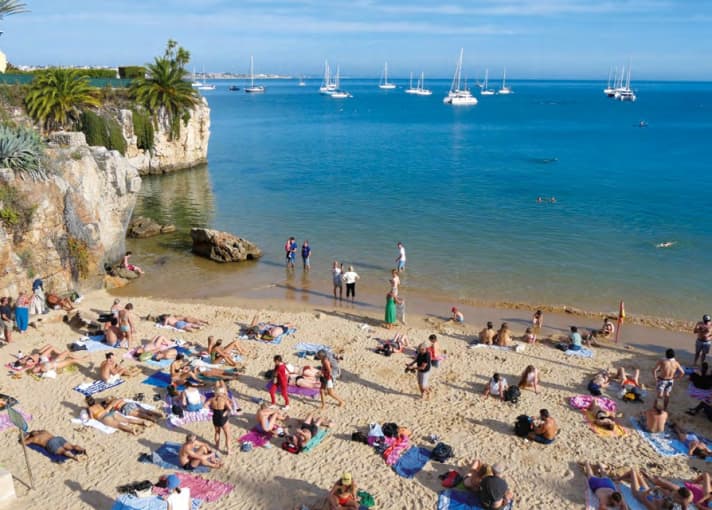
Cedeira
As soon as you enter the Ría de Cedeira, the extensive bay named after the town, the 1,400 metre long main beach Praia da Madalena and a number of smaller beaches catch the eye. Some of them can only be reached on foot or by boat. The anchorage in the eastern part of the bay, which is sheltered from the wind in all directions by the peninsula in front of it, is good. After landing with the dinghy, you can reach the town centre in half an hour on foot. Small-town life is centred around Praza Roxa. Here you will find shops, bars, cafés and restaurants. The harbour town of La Coruña, an hour's drive away, is ideal for excursions. The Hercules Tower there has been pointing the way for sailors since the time of the Roman Emperor Trajan (around 110 AD). The Museo de Belas Artes houses works by Spanish painter Francisco de Goya, among others.

Viana do Castelo
The city, which is characterised by industry and fishing, was founded in 1258 at the mouth of the Rio Lima. Located not far from Porto, it is also attractive for tourists. Beaches such as Praia do Cabedelo, Praia de Afife and Arda Beach attract swimmers, surfers and kiters. A climb up the Monte de Santa Luzia is well worth the effort. The ascent is either by car, funicular railway or a strenuous walk. The Basílica de Santa Luzia, which was only opened in 1959, is enthroned on the highest point. Yachts can moor at floating jetties in the immediate vicinity of the old town. However, there are no sanitary facilities or other infrastructure there. Those looking for more comfort and facilities should head for the marina upstream below the road and railway bridge.

Baiona
The Galician harbour town gained historical significance in 1493 when the caravel "Pinta" landed here after taking part in Christopher Columbus' first voyage to America. High above the town, the medieval fortress on Monte Real bears witness to Baiona's defence in earlier times. Today it is home to the "Parador de Baiona", a luxury hotel. The marina is sheltered at the foot of the fortress. From there, you can quickly reach the picturesque old town centre on foot. During the day, the narrow streets are bustling with activity. In the evening, the many tapas bars and restaurants with their terraces, which are still open in October, attract tourists and locals alike.

Heinz Klausmann
Also interesting:
- Seamanship: Sailing at night - don't be afraid of the dark
- The Ocean Race: 13 lead changes in two days - Cape Horn ahead
- Season start special, part 7: Safety equipment - control saves lives

